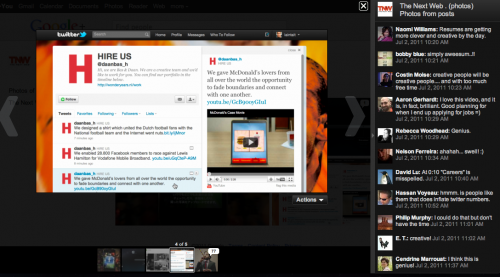
Over the last couple of years, Android has been fixing a lot of the problems that keep it from being as polished as its slicker and more profitable counterpart, iOS.
With the huge array of Android devices on the market from dozens of manufacturers, it’s incredibly difficult for applications to run identically on wildly different hardware. This means that even current Android hardware isn’t always guaranteed to run the most current version of the OS. It still has a long way to go in this department, but Google is taking steps to help fix some of the issues plaguing the platform.
One major failing of Android may have just gotten its fix directly from the mothership. Google+, if it gains traction, will give Android one of the things that it has been lacking so far, its very own killer app.
The term ‘killer application’ has been around a while. In general it describes an application written for a given platform that provides such a potent draw for users that it becomes a major, if not the main, reason to adopt that platform.
Examples of this in the non-mobile world include Microsoft Office for Windows, XBox Live, Tetris for the Gameboy and the grandaddy of all killer apps, VisiCalc for the Apple II. While some of these products no longer retain their killer app status because of deprecation or distribution, in their moment they represented a major shift in consumer support for the platforms that they appeared on.
Most of the major mobile platforms have had their version of a killer app at one point or another. These things tend to come and go a bit as products wax and wane, but they can provide a big enough effect on user influence that they drive the growth of a platform for a not-insignificant time. One of the prime examples of this in the mobile space is BlackBerry Messenger, which arguably, along with extensive enterprise support, has extended the life of the BlackBerry product by years and most likely accounts for a sizable portion of device sales.
The iOS ecosystem is an interesting case because it is so dominant when it comes to quality applications. The iPhone doesn’t have just one killer app, it has hundreds. Not that there aren’t some very nice apps for Android, but you’ll honestly find most of those hanging out in Apple’s App Store as well, and most likely making more money there too. And, alongside applications that make their primary home in iOS, there are thousands that exist there exclusively.
There are many reasons that a developer may choose to have an app available only on iOS and it would take an extensive amount of explanation to investigate all of the reasons more thoroughly. You can check out this interesting post from Sarah Chang of the husband-and-wife team at Peegos Publishing on why they’re sticking with iOS only for some interesting insight.
But in the end, most major applications will probably end up taking the multi-platform route. Once the Android ecosystem becomes less fragmented and increases its attractiveness in terms of revenue, we could very well start to see pretty much every major app release on both platforms.
Which brings us to Google+, which is available now for Android and will be soon for iOS. While we haven’t seen the iPhone version yet, its easy to assume that it will have at least the same level of polish in its presentation as the version on Android. In fact, because of factors like platform maturity and fragmentation, the iPhone version of the Google+ app may actually be more pleasant to interact with than the Android version.
So, if Google+ will be available on both platforms and may very well work just as good, if not better, on iOS, then how could it possibly be Android’s killer app? The key to the answer is a shift in the way that we define a killer app on a mobile platform.
The instigators of this shift are simple and obvious, Facebook, Twitter, LinkedIn and all of the other major social networks have made it impossible for a killer app to be a self contained experience that is isolated on the device. Instead it must have an aggressive social component that makes the device feel alive and connected.
It doesn’t matter how many hundreds of thousands of apps that an App Store has any more. The apps that are the most likely to engage the attention spans of users in an intense way and continue drawing them to the platform in the long term are those that offer a constant influx of content from social networks.
I was talking with a friend about closing his Twitter account, which he did on a whim. The thing that stuck out for me the most is the way that it affected the amount which he used his phone. He found himself picking it up and turning it on much less, even though he has dozens of apps on it, because he new that there was really “nothing new” to look at.
Give it a try yourself, delete your Twitter, Facebook and Instagram apps from your phone and see how much it affects your desire to pick it up and look at it just to see what’s happened in the past 30 minutes on your networks. It’s stunning how much the apps that give us access to our social networks drive the use of our mobile devices.
Google+ taps into this need on a basic level, providing Android users a reason to pick up and use their devices even more. This is what the platform needed, an aggressive play by its creator to give its users something to gloat about. A way to justify their love of the platform and the feeling of support that has, up to this point, been lacking from Android’s creators.
With Google+, Google is casting a spell of longevity and relevance on its mobile platform in a way that no amount of cheap hardware sales could ever do.
Because Google+ is also available on the iPhone you may be tempted to downplay the significance of the app for the Android ecosystem. But, in fact, Google+ was created to inherently take advantage of the more open architecture the Android platform offers. Google will be able to do things with the app on its platform that would never happen on iOS.
Things like a Hangout or Huddle widget, the system wide integration of Google+ into the OS to capture photos and videos or email addresses and phone numbers categorized by Circles will only exist on Android. In the end, it’s safe to say that Apple will never integrate even basic Google+ functionality into the innards of the iPhone’s OS.
And it’s not enough that Apple has its own equivalents to some of these features in its iCloud suite. for instance, every picture can be automatically uploaded to your Google+ gallery every time you press the shutter button of an Android phone, mimicking the behavior of the Photo Stream in iOS. But these photos cannot be instantly shared with a Circle of your friends, they can’t be viewed in a gorgeous, socially enabled, online gallery.
Google is positioned to offer its users an extensively social connected web experience to go along with the mobile app that Apple can’t hold a candle to.
Apple is definitely aware of the potential of this kind of integrate, they have been experimenting with social integration for some time now, as evidenced by the appearance of a Facebook system settings option in unreleased betas of iOS 4. We know now that they ended up making a deal with Twitter instead and will offer extensive sharing options from within system apps in iOS 5. This still leaves them without an overarching web presence, despite the (for apple) strong social media play that a deal with Twitter represents.
At this point Google+ is still incredibly fresh, with little indications as to its long-term status as a major social network that can play in the same leagues as Facebook and Twitter. Early signs point to widespread adoption among the technorati, but we’ve seen this before with services like Quora, which got great initial traction but has yet to reach the tipping point of momentum it needs to get truly big.
If, and it’s admittedly a big if, Google+ manages to gain traction in the crowded social space, then it stands to garner Google a great toehold in the online social space that will help it to shed its ‘service toolbox’ reputation. It will also give the media giant another place to show its advertising which, lest we forget, is what pays for all of this network building.
But the real winner here isn’t Google as a company, its Android, which will finally get its killer app and a definitive answer to the question “why Android?”
Get the TNW newsletter
Get the most important tech news in your inbox each week.





